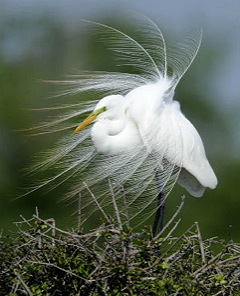
A displaying Great Egret is emblematic of America’s colonial-nesting waterbirds.
|
The Texas Parks and Wildlife Department is cautioning Texas boaters and anglers to watch out for nesting birds, which are particularly sensitive to human disturbances. With spring approaching, iconic coastal birds like Brown Pelicans, Roseate Spoonbills, Black Skimmers, and Reddish Egrets are starting to build nests, lay eggs, and raise nestling in colonies on small inshore islands along the Gulf Coast of Texas. The nesting islands may support thousands of birds that utilize much of the available island habitat.
“Waterbirds, and the habitats they call home, are extremely valuable to Texas,” said TPWD diversity biologist Trey Barron. “Reddish Egrets are a charismatic coastal specialist and state threatened species that attract visitors from all of the world who come to see them chasing prey in the shallow waters.”
Of about 25 species considered to be colonial nesters in Texas, more than half are experiencing major population declines. Colonial waterbirds typically nest from late February through August when recreational use by coastal anglers and boaters is highest, putting them at greater risk of coming into contact with people. Disturbance by humans can lead to nest failure and, in some cases, complete abandonment of a nesting island or coastal nesting area.
“When approached too closely by boaters or people wading nearby, birds are frightened off their nests, leaving eggs and nestlings exposed to rapidly overheat in the summer sun and allowing opportunistic predators like gulls and grackles to quickly swoop in and prey on them,” said Barron. “With too many disturbances, an entire nesting colony of thousands of birds may abandon an island and give up on nesting for the year. Over time, this can potentially lead to drastic population declines.”
The Texas Colonial Waterbird Society – a large partnership of federal and state agencies, universities, and non-profit organizations – has conducted an annual survey since the early 1970s to track waterbird populations and island conditions. The survey data is used to help establish population goals and identify management needs. Some member organizations actively manage the islands to improve habitat, restore acreage lost to erosion and storms, and place protective signs along shorelines to identify rookery islands to boaters and anglers.
Colonial-nesting waterbirds and their nests, eggs, and nestlings are protected under the federal Migratory Bird Treaty Act and by Texas Parks and Wildlife Code. The Texas Colonial Waterbird Society recommends that people fish, swim, and play at least 50 yards away from rookery islands to minimize unintentional and potentially illegal disturbances. (The farther away, the better.)
In addition to avoiding rookery islands during the nesting season, it’s important for coastal boaters and anglers to properly dispose of fishing line, tackle, and other waste to ensure that no birds, turtles, or other marine life become entangled, injured, or killed.
The habitats that waterbirds use are the same habitats where we enjoy fishing, boating, and photographing wildlife. Barron said, “We just have to remember to give them their space, especially during the nesting season. If you’re on the water, look for the yellow signs that identify rookery islands and keep your distance. We can all enjoy the same places as long as we do it responsibly.
For more information visit https://tpwd.texas.gov/huntwild/wild/wildlife_diversity/tcws/.
To view a video public service announcement urging people to keep their distance from waterbirds, visit https://www.youtube.com/watch?v=1xP3xY3-CS8